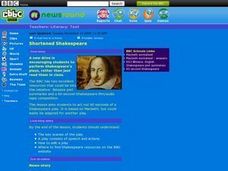EngageNY
Grade 10 ELA Module 4: Unit 2, Lesson 15
What goes around, comes around. Using the resource, pupils read Act 4.3 of Macbeth, in which Macduff and Malcolm plan to attack Macbeth. Scholars then hold a discussion and complete writing activities to analyze Shakespeare's structural...
EngageNY
Grade 10 ELA Module 4: Unit 2, Lesson 2
What is the best way to determine the theme of a text? Pupils analyze how central ideas emerge in Shakespeare's tragedy Macbeth. They work in small groups and engage in a whole-class discussion to discuss the play's plot. Finally,...
EngageNY
Grade 10 ELA Module 4: Unit 2, Lesson 9
How does Shakespeare develop the central idea of agency versus fate in Macbeth? Using the resource, pupils work in small groups to discuss the plot of Act 3.1. Next, they complete a brief writing assignment to analyze how the main idea...
EngageNY
Grade 10 ELA Module 4, Unit 2, Lesson 26
How do directors' choices emphasize different elements of a drama? Scholars participate in a discussion about the Royal Shakespeare Company production of Macbeth and Akira Kurosawa's Throne of Blood. Finally, they write an analysis of...
Curated OER
Hamlet Research Paper: Find, Evaluate, and Select Appropriate Research Sources
Help young researchers find credible sources online. Modeling with a Google search for information about Shakespeare’s Macbeth, use a computer projector or Smart Board to show class members how weak the top three search results are....
Literacy Design Collaborative
Whom Do We Trust, and Why?
Is it possible to regain trust? Scholars put much thought into the subject of trust after reading Shakespeare's Macbeth. Readers work together to analyze how the character relationships develop the a message about trust. They then create...
Curated OER
Screwing Courage in Macbeth
High schoolers read, analyze, and act out the scenes 1.7.29-79 of the William Shakespeare play, "Macbeth." They discuss motivation, tactics, and obstacles, and improvise scenes suggested by the class.
Curated OER
When Shall We Three Meet Again?
Double, double toil and trouble; Fire burn, and caldron bubble. Macbeth’s witches provide young actors an opportunity to try their hand at small ensemble acting. Using Act I, scene I of Shakespeare’s play, groups of three take turns...
Curated OER
Acting in Marriage-Is It on Stage or Off?
Learners compare views of marriage in Macbeth and Cat on a Hot Tin Roof. In this comparative literature instructional activity, students discuss and debate the marriages of Macbeth and Lady Macbeth in Shakespeare's Macbeth Brick and...
Curated OER
An Actor's View of Shakespeare
Students research characters from different plays. In this Shakespeare and performing arts lesson, students discuss the portrayal of characters from the perspective of real actors. Students work in groups to examine the technique for...
Curated OER
Shakespeare's Macbeth: Fear and Motives of Evil
Learners complete play and vocabulary analysis for William Shakespeare's Macbeth. In this Macbeth analysis lesson, students use an online research engine to locate passages that highlight Macbeth's response to fear and his descent into...
Curated OER
Macbeth Madness
Students analyze Shakespeare's Macbeth by completing the creative activities. In this Macbeth lesson, students discuss the timeline for William Shakespeare and identify the characters for Macbeth. Students read Act One, Scenes i-v of...
Curated OER
The 32-Second Macbeth
Pupils read a very short script synopsis of Macbeth. They read the script, in small groups, trying to break the 32-second record, then write their own 32-second versions of one act from Macbeth.
Curated OER
Macbeth
Students examine patterns of imagery in Macbeth by using online resources. Students compare the patterns they see to those they've found in other Shakespeare plays. Then students draw conclusions about why Shakespeare might have used the...
Curated OER
Macbeth and Lady Macbeth's Tortured Sonnet
Students read four of Shakespeare's sonnets and determine whether they are read from Macbeth's or Lady Macbeth's point of view. They support their decision using evidence from the text.
Curated OER
Shortened Shakespeare
Young scholars discover the two main ingredients of a play: speech and actions. They then listen to a shortened version of "Macbeth" and write down one sentence to describe what is happening in each of the comic-strip cells.
Curated OER
When Fair is Foul: Paradox and Equivocation in Macbeth
Pupils read Macbeth for examples of paradox and equivocation in the text. In this literature-response lesson plan, students work in groups to analyze Shakespeare's writing for use of paradox using handouts to guide their search. Student...
Curated OER
Macbeth: What's Up with the Crime Scene?
High schoolers are introduced to Macbeth by having them act out the scene where Duncan's murder is discovered. This activity enable students to use dialogue only to discover the structure and format of a scene and explain plot.
Curated OER
The Macbeth Tango
Students examine how Macbeth and Lady Macbeth relate to each other in individual scenes and throughout the play. By taking elements of that relationship and making them physical, students analyze the Macbeths' marriage on many different...
Curated OER
Literary Response and Analysis
Students analyze the archetype of 'the fall' in Shakespeare's Macbeth. In this literary analysis lesson, students work in tiered learning groups to analyze the characters of Macbeth and Lady Macbeth. Students use the book of Genesis as...
Curated OER
The Portrayal of the Witches
Eleventh graders discover the importance of the fortune teller in Shakespeare's Macbeth. After watching two interpretations of the play, they examine and compare the portrayal of the character. They create their own modern adaptation of...
Curated OER
So Foul and Fair a Play
Students watch various interpretations of Shakespeare's Macbeth in film. In groups, they examine the setting, characters, music and sequence. They compare and contrast the various films and discuss the differences. They write an essay on...
Curated OER
Macbeth: Shakespeare for Elementary Students (Elementary, Literature)
Students act out a fully realized Shakespearean play designed to be utilized by mid level elementary students.
Curated OER
Parodies of Shakespeare
Students view a video clip about parodies. They identify the characteristics of a parody in Mark Twain's work as well. They practice writing Shakepeare like verses.

























